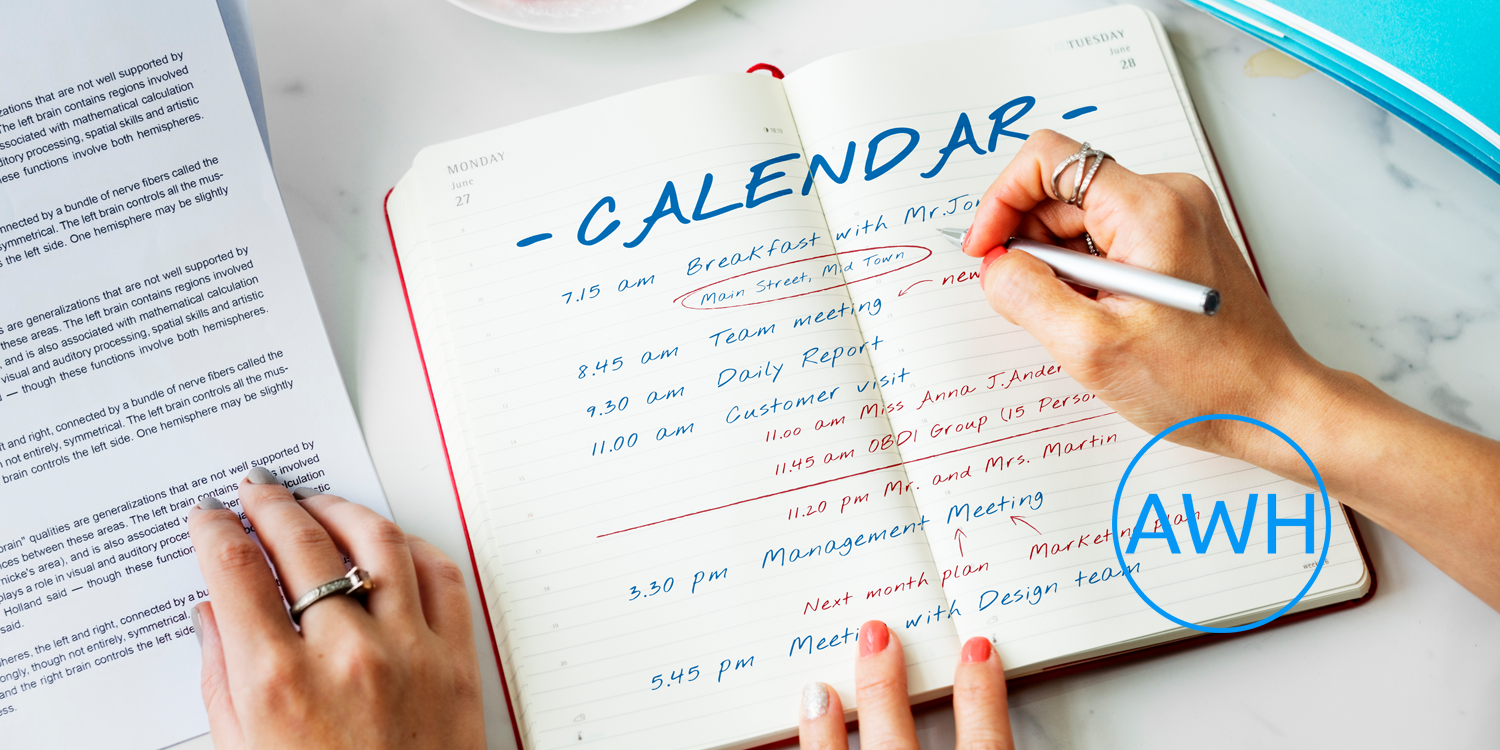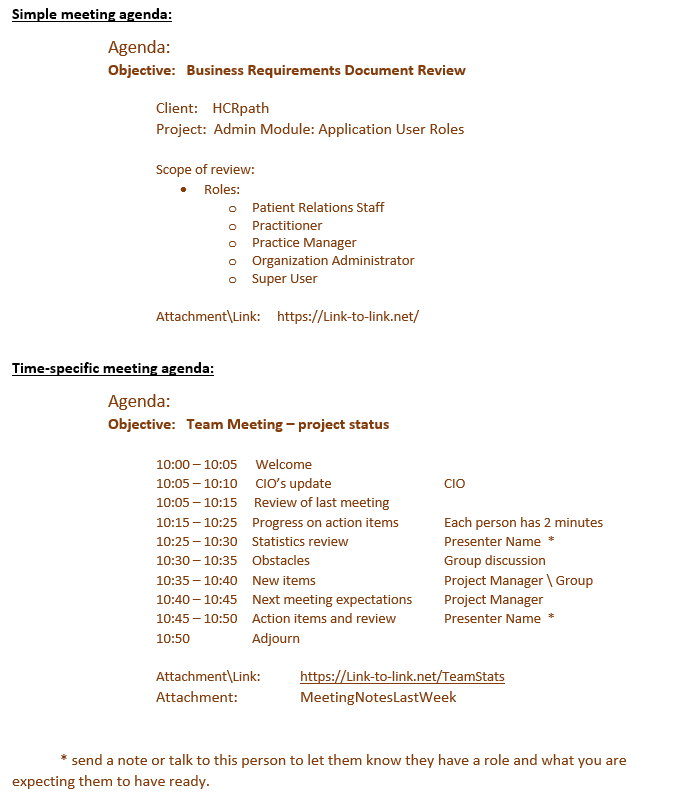Meeting Agendas — a Necessary Evil
Nancy Zaiser | July 20th, 2020

Let’s take a quick quiz. Give yourself one point for every meeting experience you’ve had:
1. My time was wasted. I didn’t need to be there.
2. The discussions taking place didn’t pertain to the meeting objective.
3. The meeting was irrelevant to me and my work.
4. I’ve already been to a meeting where this was discussed.
5. I was surprised by something that I should have known sooner.
6. I had to wait while the meeting leader helped someone get caught up.
7. I was asked to speak about a topic, and I wasn’t forewarned or prepared to do so.
8. The meeting handouts were hard to skim and understand during the meeting.
9. I couldn’t figure out the point of the meeting.
10. The meeting started out okay but ended up not achieving anything or, even worse, messed something up.
11. The meeting leader was not organized, so the meeting was all over the place.
12. The meeting leader was not in control, so the meeting derailed.
Unless you’ve only recently had your very first-ever meeting, I suspect your score was at least five if not twelve! Why? What happens to cause a meeting to derail? Or, maybe the question should be what causes a meeting to be successful?
Think about the meetings you consider successful. Was there a meeting objective? Were the conversations all related to the meeting objective? Was the meeting leader organized and in control?
Yes! But, HOW do they do that?! The successful meeting leader begins controlling the meeting before it ever happens. It starts with planning, which results in an agenda. This is not a super-power. Anyone can do this!
I have outlined seven steps to creating an effective meeting agenda. If you have answers to each of these questions, it will assist you in running a more successful meeting.
1. Clarify the objective of the meeting.
What needs to change from the time the meeting starts until the time everyone walks away? Do you need to impart knowledge, make a decision, take action, create a plan, generate ideas, or something else? You will need to clearly state that objective in terms that ALL members of your audience will understand.
2. Define your audience.
Do you need to make a decision? Figure out who has the authority to do that and who has the information necessary for the decision to be made.
Do you need to inform people of something? Establish who needs the information, who has the information, who can answer any questions that come up and if an authority figure, like a Human Resources representative, is needed.
Do you need to take action? Who has the ability, the capacity, the time, and/or the authority to delegate resources to do it? You will need to include those who will be responsible for taking this action. Experiencing the discussion will provide valuable insight into the reason behind the action.
Do you need to brainstorm, to generate ideas? Establish who is able to clearly articulate the subject to be resolved and who has the knowledge to generate viable ideas. In this instance, don’t make the mistake of underestimating a junior or new contributor. They may possess a fresh perspective that will lead to new possibilities. Does everyone who is ‘familiar’ with the topic need to attend? If this meeting is designed to share information with a new group of people, it may not be necessary to have everyone who is already involved attend. It may be redundant for them and a waste of their time. Be careful to not exclude those who may be able to contribute to the conversation through a deeper understanding or an ability to relate the topic to the new audience’s concerns.

3. Create an agenda.
You will want to clearly state the objective of the meeting. Highlight the agenda text in some way like emboldening, underlining, different color, larger font, etc. Then, list the meeting talking points or topics. Keep in mind you will want to limit the meeting to topics that support your objective.
Decide the order in which to discuss the topics then PRIORITIZE. That way, if a topic’s discussion runs long, you have options that can be cut from the agenda and addressed later. If a subtopic’s relationship to the meeting objective is not clear, briefly explain it.
Group related topics together. Grouping topics will allow people to participate in the portion of the meeting that pertains to them and not have to sit through topics that are not relative to their needs or ability to contribute. This is especially helpful for longer meetings and events. You will also want to address your attendance expectations (ie can they arrive when their topic is scheduled, they are free to leave after the topic has been discussed, or are they expected to arrive at the beginning and stay for the entire meeting.)
4. Manage Expectations
If your guests will be expected to ‘present’ on a topic, let them know before the meeting, or ideally, even before you send out the agenda and secure their commitment to participate. Depending upon the sensitivity of the topic, you may want to discuss the content of their input before the meeting. Make sure they know your expectations if they are to provide handouts, what specifically do you want them to cover, and how long do they have to speak.
5. Add a timeline to your agenda.
Determine the amount of time necessary to adequately address the topic. It helps to list these times on your agenda. This is especially important for longer meetings and events so that people can plan to attend the part that is relevant to them.
6. Prepare pre-reads for your audience.
If you expect your audience to come with advance-knowledge of the topic, provide links to information or attach documents for them to read in advance. If you need to decide something, provide relevant information. If your objective is to generate ideas, provide context about the topic. Include any ideas that have already been brought forth. Provide guardrails such as resource boundaries, time-related constraints, or ideas already discussed. If you need to inform, provide supporting information. Caution: if the information to be shared is inflammatory or may cause fear or panic, be judicious in what and how you share. Still, try to find a way to express the importance without inciting fear or frustration.
If you expect your attendees to come to the meeting with the information already read or documents filled out, be sure to state that expectation clearly in a bullet point, not in the middle of a paragraph. Did you catch that, or did you read the bolded text below first!?
##Expectation: Bring your completed form to the meeting!##
7. Include the agenda and all pre-reads in the meeting invite.
Avoid paragraphs in an agenda, it’s better to use bullet points, topic headers, and highlighting to draw people’s attention to the important information.
Let’s face it. Meetings are necessary, but sometimes they impede our productivity. It is important that we try to make them as relevant, efficient, and as time-sensitive as possible. Sometimes a small, informal, quick meeting is all that is required, and no agenda is necessary. However, for a larger or more focused meeting, detailed agenda can facilitate a great meeting before and during the meeting.
In all instances, if you are sending a meeting invite always include the topic. If an entity distinction is necessary, be sure to include a client or company name to give the invitees enough information to plan for the meeting or send appropriate delegates.
The benefits on an agenda are subtle but impactful. Minimally, people will appreciate knowing what to expect. Ultimately, an agenda can be the foundation for controlling the meeting flow and ensuring your meetings are productive.
The first few times you do this people may not pay much attention. However, if you run your meeting from the agenda and hold to its content and timeline, they will soon begin to come better prepared. They will be better prepared to contribute, to expect a relevant, focused, succinct meeting that meets its objective, adheres to the agenda, and ends on time.


